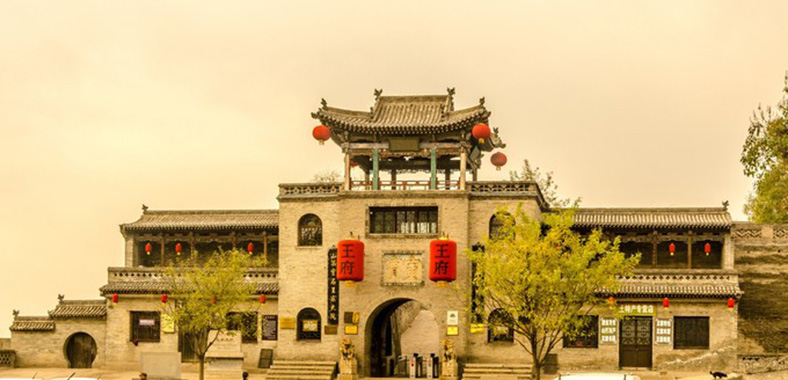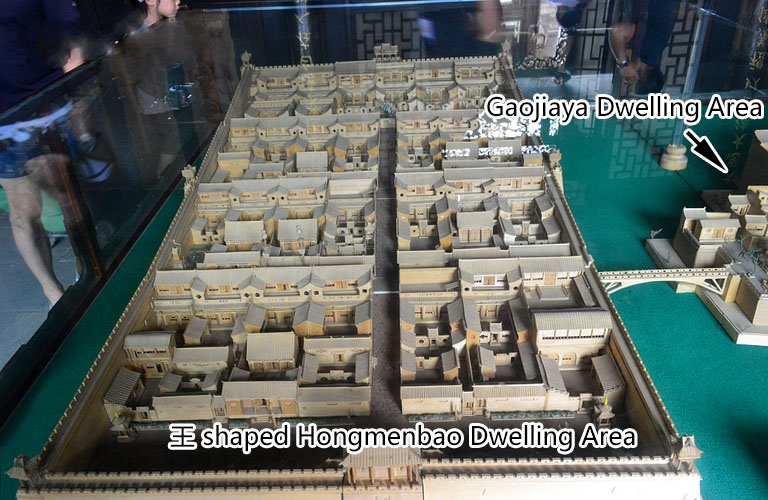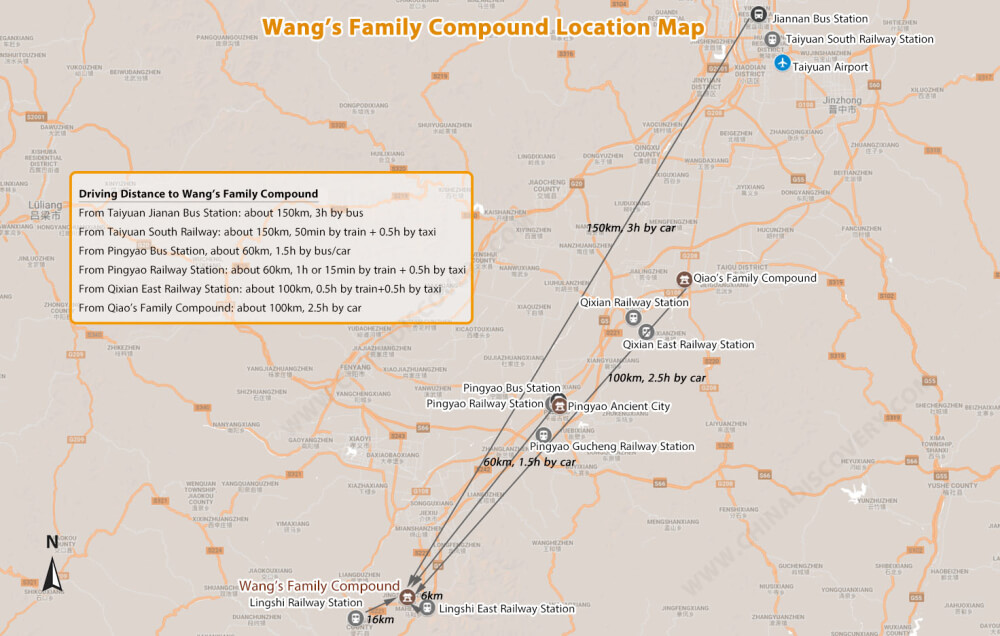When traveling Shanxi, many people may hear about Wang's Family Compound for its great fame. But the biggest and most classic residential family compound in Shanxi Province is located in Jingsheng Town, Lingshi County, namely Wang's family compound.
Wang's family was built in the Ming and Qing Dynasties for more than 300 years, including five lanes, six fortresses, and one street, with a total area of over 250,000 square meters. It is exquisite, beautiful, novel, elegant, and delicate in many ways with the local residential and architectural features. Therefore, there are the sayings in Shanxi, that "Back from Wang's Family Compound, there is no desire to expect better ones." and "the No. 1 family compound of China". In 2008, it was listed in UNESCO World Heritage Tentative List in the cultural category.
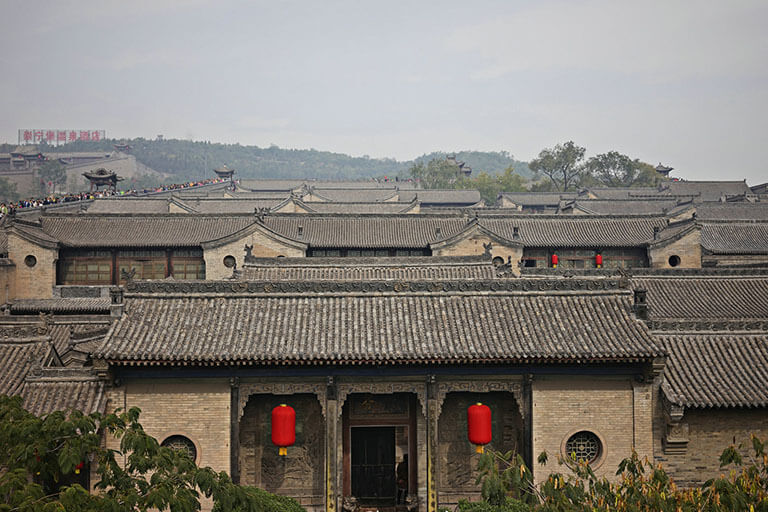 Wang's Family Compound
Wang's Family Compound
Where is Wang's Family Compound
Built on the slope of Mianshan Mountain and facing a river, Wang's family compound is located on multiple levels at different elevations of Jingsheng Town, Lingshi County, south region of Jinzhong city, which is about 150km away from Taiyuan, 60km to Pingyao, 100km to Qiao's Family compound.
• Location: Jing Sheng Sheng Town, Lingshi County, Jinzhong City, Shaanxi Province 陕西省晋中市灵石县静升镇静升村
• Recommended Shanxi Tours with Wang's Family Compound: ☛ 2 Days Classic Pingyao Ancient City Tour
History of Wang's Family
Wang's family originated from Taiyuan. In the reign of Emperor Renzong of Yuan Dynasty (1312-1313), the ancestor of Wang Shi moved to Jingsheng Village. Jingsheng Wang's family started farming and selling tofu. From peasants to commerce workers, from business men to government officials, Wang's family started to thrive and became rich, and their wealth came up with a lot of real estate generation after generation. Eventually, they built a huge complex of buildings such as "Three Alleys, four castles, and five ancestral halls". The family had kept flourishing even in the early years of the Qing Dynasty, and they did many good deeds, like building schools, road construction, excavating water canal, etc.
However, after the 18th century (during the reign of Daoguang in the Qing Dynasty), Wang's family compound gradually declined and the compound was partially sold to other people. During the Anti-Japanese War, it was said that Wang's family fled to Sichuan to seek refuge, and since then the compound has been uninhabited.
Layout & Structure of Wang's Family Compound
The architectural style of Wang's family compound inherits the courtyard style of the front hall and back bedroom formed in the Western Zhou Dynasty. It not only provides enough space for external communication but also meets the requirements of the internal private atmosphere. The layout of the rooms was built orderly by generations, hierarchy, gender, and usage. After the war, only one-fifth of the former family compound is open to the public, namely, the Gaojiaya dwelling area and the Hongmenbao dwelling area. There are 231 large and small courtyards, 2078 houses with an area of more than 80,000 square meters, which are way more bigger than Qiao's family compound.
In Gaojiaya, there are 35 large and small courtyards and 342 houses. The main courtyard of Dunhou and Ningrui residences are both three courtyard houses. In addition to the ancestral worship hall and side buildings, each courtyard has its kitchen yard, private school courtyard, and shared academy, flower yard, servant courtyard, kitchens, schools, and prayer pavilions, etc. The surrounding walls are closely enclosed. The large and small courtyards are a perfect match. The ornate stone, brick, and wood carvings have themes based on folk customs and folk arts. There are total 65 doors connecting the upper and lower parts of the courtyard. Crossing a narrow stone bridge is the Hongmenbao building complex, which is castle-like, built on the mountain. The courtyard is arranged on four floors, symmetrical on the left and right, with a main road in the middle, forming a very regular Wang's shape in Chinese "王". At the same time, it implies the shape of a "dragon" and the 88 courtyards in Hongmenbao have their own characteristics.
• Recommended Shanxi Tours with Wang's Family Compound:
☛ 3 Days Pingyao Discovery Tour
☛ 4 Days Essence of Datong & Pingyao Tour
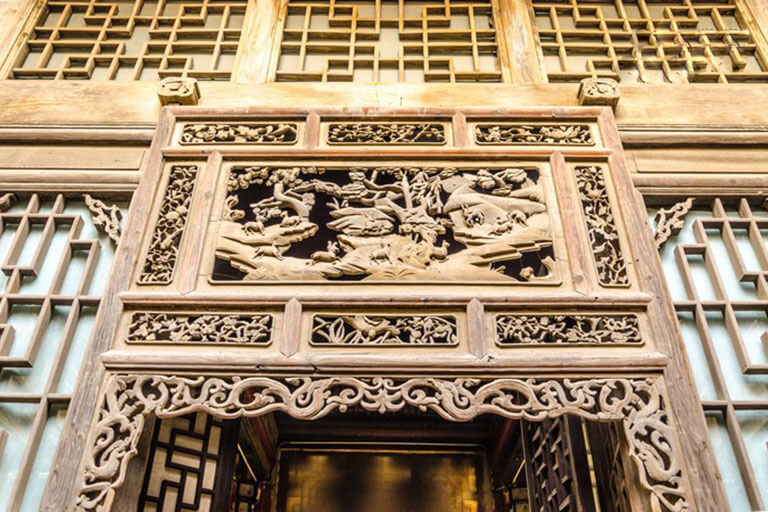 Exquisite Doorframe Carvings
Exquisite Doorframe Carvings
Gaojiaya Dwelling Area 高家崖
Gaojiaya, built by Wang brothers for 16 years, is the largest, most exquisite, most accomplished, and most beautiful place in the whole family compound. Compared with the local cave dwelling style, the residence with red lanterns and the bricked wall is very outstanding. The first courtyard belongs to the elder brother, Wang Rucong (王汝聪). He is older, but his official position is lower than his younger brother Wang Rucheng. The main gate faces a beautiful exquisitely decorated wall with stone cravings of a lion rolling around hydrangea, which has the meaning of happiness and auspiciousness. When you are in the courtyard, the most striking thing is that you can see all kinds of carvings, ranging from doors and windows to porches and pillars. It seems that the owner's desire for wealth reflected on the carvings which symbolize prosperity. The second floor of Wang Rucong's former residence is dedicated to Wang's ancestors, which reflects the concept of inheriting the Chinese family's lineage by descendants. Through an arch is the courtyard of his younger brother Wang Rucheng (王汝成), whose position in office is relatively high. The decoration of Wang Rucheng's courtyard is more magnificent than that of his older brother Wang Rucong. The open wooden corridor has become a brick structure, and the carving on the top of the door is more gorgeous. The walls have been painted, and the furniture is more exquisite. Even the color painting of the wainscot is more delicate and bright. In the courtyard between the two brothers is a home school (养正书塾), where there are many fine works of carving art, exquisite door frame, and even the stairs have carved marks.
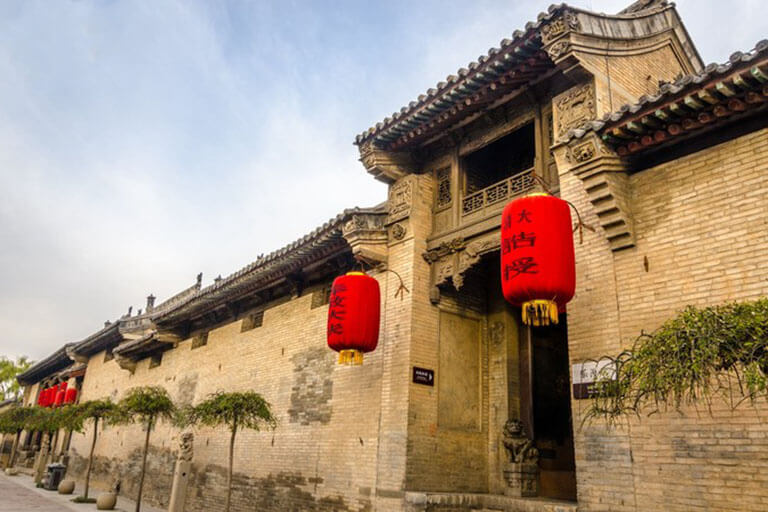 Gate to Wang Rucong's Courtyard
Gate to Wang Rucong's Courtyard
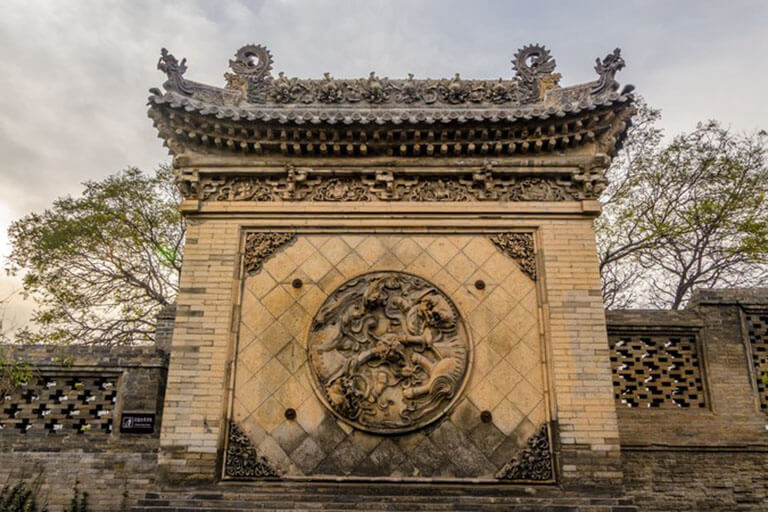 Stone Cravings of Lions
Stone Cravings of Lions
Hongmenbao Dwelling Area 红门堡
Located on the right side of Gaojiaya, Hongmenbao was built from 1739 to 1793. There are 88 courtyards and 776 houses with a total area of 25,000 square meters. It has four rows of courtyards, which are symmetrical from the left to the right. The middle main roadway and three cross lanes form a regular Wang character in Chinese "王". In addition to the courtyard in the front hall and the back bed, part of the courtyard should be changed into the front garden and back yard to conform to the geographical conditions. Because some courtyards were built in the early Qianlong period, their decoration is delicate, close to the style of the Ming Dynasty. The architectural styles of various courtyards in Hongmenbao are basically in the same style, and there are many kinds of exhibition halls scattered around such as Wang's Museum of China, painting and calligraphy Museum, treasure house, humble residence tea house, Wang's vinegar workshop, Wang's tofu shop and the photo exhibition of the Jin Merchants (Shanxi Merchants), all of which have been opened to visitors to learn about history, the rise and fall of Wang's family.
• Recommended Shanxi Tours with Wang's Family Compound:
☛ 6 Day Datong Pingyao Tour Plus Wutaishan Visit
☛ 9 Days Ancient Treasures of China Tour
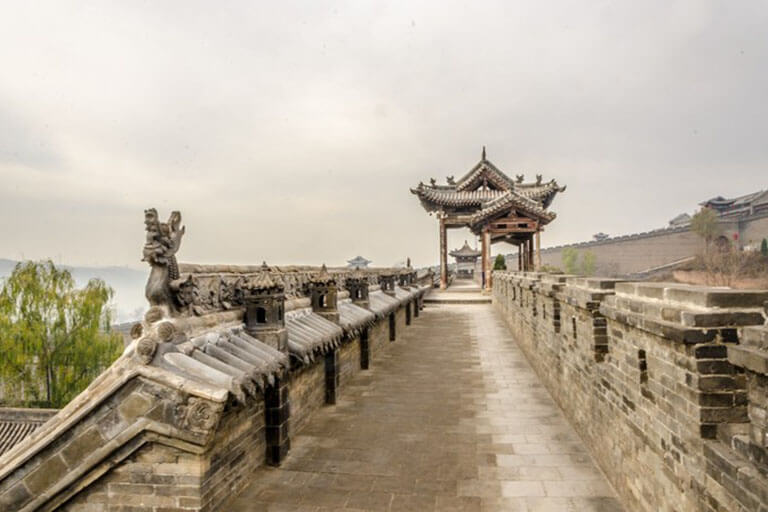 Ancient Walls of Hongmenbao
Ancient Walls of Hongmenbao
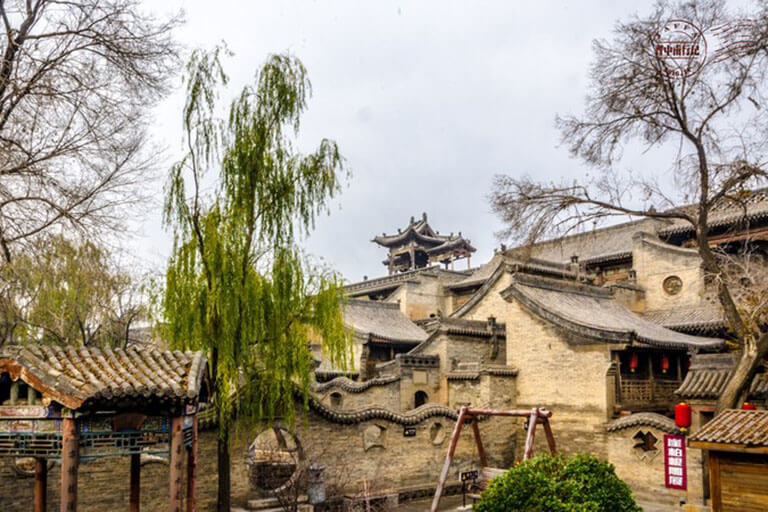 Garden and Pavilion of Hongmenbao
Garden and Pavilion of Hongmenbao
How to Get to Wang's Family Compound
▶ Pingyao to Wang's Family Compound: The driving distance from Pingyao Ancient City to Wang's Family compound is about 60km, and the driving duration is about 1 to 1.5 hours. Besides driving there, you can also take a direct tourist bus from 7 am to 11 am departing from Pingyao Bus Station located right next to Pingyao Ancient City, and the duration by bus is about 1.5 hours. You can also take a train from Pingyao Railway Station or Pingyao Gucheng Railway Station (High-speed train station) to Lingshi Railway Station/Lingshi East Railway Station (High-speed train station). Taking a normal train is about 1 hour, while the high-speed bullet train only costs about 15min. After you get to the railway station in Lingshi, you can easily grab a taxi to Wang's Family Compound.
▶ Taiyuan to Wang's Family Compound: It's about 150km from Taiyuan to Wang's family compound, taking about 3 hours bu car. You can take a bus at Taiyuan Jiannan Bus Station (太原建南汽车站 location: No.1, Dicun Street, Xiaodian District, Taiyuan City 太原市小店区狄村街1号) to the scenic site directly, while the most comfortable way is taking a high-speed train from Taiyuan South Railway Station to Lingshi East Railway Station which is only about 6km to the family compound and the duration by high-speed train is about 50min.
▶ Qiao's Family Compound to Wang's Family Compound: The driving distance from Qiao's family compound to Wang's family compound is about 100km, about 2.5 by car. There is no direct bus running between them, and most visitors would like to travel to them via Pingyao. If you want to get from Qiao to Wang, the most recommended way is to get from Qiao's family compound to Qixian East Railway Station and take a high-speed train there to Lingshi East Railway Station and take a taxi to Wang's family compound. The whole duration is about 1.5 hours including 0.5 hour on the bullet train and about 1 hour by taxi.
Nearby Attractions
Pingyao Ancient City
60km away from Wang's family compound, Pingyao Ancient City, with over 2700 years of history, still keeps its authentic layout and style intact: ancient city walls, elegant residences, and courtyards, vertical and horizontal streets, and alleys, scattered ancient banks and escorts, all marked a prosperous county during Ming and Qing dynasties. Named one of the Four Most-preserved Ancient Cities in China, it was also a UNESCO World Cultural Heritage Site which was listed with Shuanglin Temple, Zhenguo Temple in 1997.
Qiao's Family Compound
When mentioned about Wang's family compound, people also compare it to the famous Qiao's family compound 150 km away. Though it is much smaller than Wang's, Qiao's Family Compound is delicate and representative. With unique patterns and vivid carving, it reflects the unique living styles of northerners in ancient China during the Qing dynasty, also legendary life stories of Shanxi merchants (Jin merchants).
 Courtyard of Qiao's Family Compound
Courtyard of Qiao's Family Compound
How to Plan Your Pingyao Tour with Wang's Family Compound
Best time to visit Pingyao: March to mid-June, mid-September to November, and Chinese Spring Festival Time (Jan or Feb)
Where to Stay: Mainly in Pingyao Ancient City.
Only 60 km away from Wang's Family Compound, Pingyao is noted for the World Heritage Site - Pingyao Ancient City. It is well-preserved, keeping the architecture style of the Ming and Qing Dynasty (14th-20th centuries). Most people will choose to visit them both. You can leisurely stroll and get to learn about the traditions of the northern Chinese, especially during the Chinese Spring Festival. Usually, 2 to 3 days are enough for you to explore the attractions in Pingyao, including scenic sites and ancient streets of Pingyao Ancient City, Qiao's Family Compound, Shuanglin Temple, etc.
☛ 2 Days Classic Pingyao Tour
☛ 3 Days Pingyao Discovery Tour
Also, Pingyao is well connected with many other cities in Shanxi province. You can spend more days having a Shanxi discovery tour: witnessing the stunning Yungang Grottoes and Hanging Temple in Datong, hiking on and the famous Buddhism mountain, Wutaishan, visiting the magnificent Hukou Waterfall, and getting to Jinsi Temple and Shanxi Museum in the capital of Shanxi province, Taiyuan.
☛ 4 Days Essence of Datong & Pingyao Tour
☛ 6 Days Essence of Shanxi Tour
☛ 12 Days Historical China Tour with Train Experience
If you would like to travel outside Shanxi, you can take a flight from Taiyuan to many other cites of China. It is also very convenient to take a high-speed train from Pingyao/Taiyuan to Xian and Luoyang with no more than 4 hours or head to Beijing by high-speed train.
☛ 4 Days Ancient Pingyao & Xian Tour
☛ 6 Days Beijing Pingyao Highlights Tour
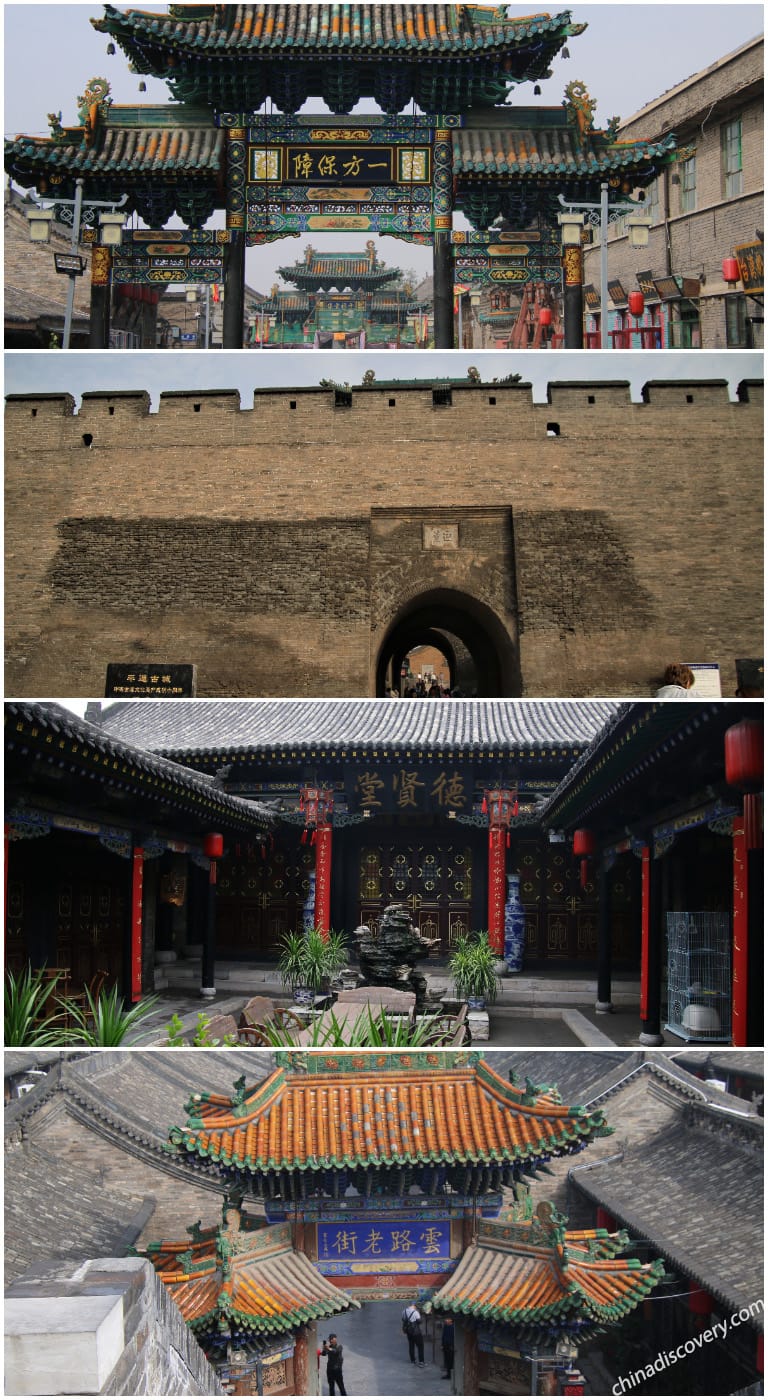 Ancient Sites of Pingyao
Ancient Sites of Pingyao
More Attractions in & near Pingyao
Pingyao Travel Guide
- Popular Pingyao Tours 2025
- Ultimate Pingyao Travel Guide
- Pingyao Trip Planner
- Top Things to Do
- Top Pingyao Attractions
- Wang's or Qiao's Family Compound
- Featured Nightlife, Activities & Festivals
- How to Get to & around Pingyao
- Pingyao Weather & Seasons
- Where to Stay in Pingyao
- Useful Pingyao Travel Maps
Other Popular Shanxi Destinations
Recommended Pingyao Tours
Top 3 Pingyao tours chosen by most customers to explore Pingyao in the best way. Check the detailed itinerary, or tailor your own trip now with us.

4 Days Essence of Datong & Pingyao Tour
Datong / Pingyao
Start planning your tailor-made holiday to China by contacting one of our specialists. Once inquired, you’ll get a response within 0.5~23.5 hours.
Customize a TripHave a question? Get answers from our travel experts or guests
- Your Question:
- Your Name:
- Your Email:
- Submit

























